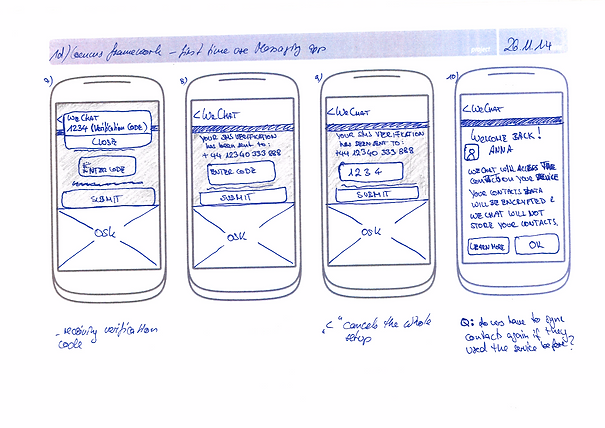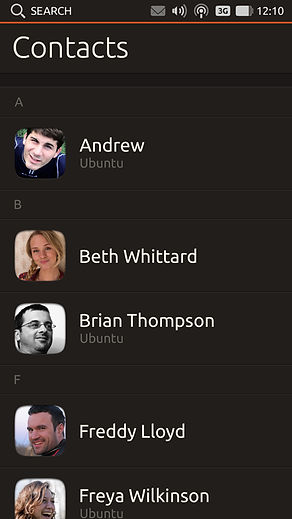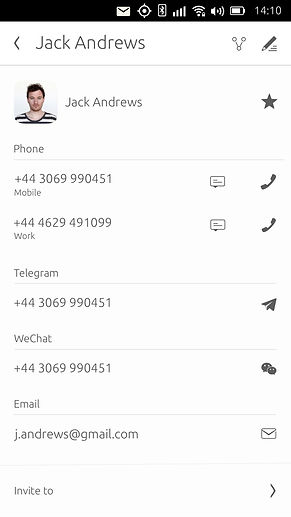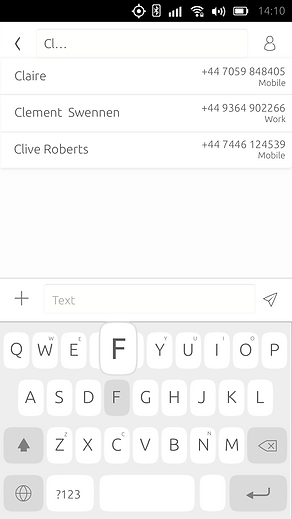
UBUNTU TOUCH
WHEN
2013 - 2015
COMPANY
Canonical Ltd.
WHAT I DID
UX Design
MY ROLE
When I joined Canonical in 2013, Ubuntu OS was already a well established open source platform used by millions of people all over the world. Ubuntu Touch was created as the next iteration of the platform to embrace the new capabilities of mobile devices, with the goal of full convergence of traditional PC and modern touch UI. The Design team worked with both in-house and community/volunteer developers on the product since 2012.
Right from the start at Canonical I was given the responsibility to evolve the essential mobile applications for telephony: Dialler, Messaging and Address Book. I led the UX over several release cycles to developers, partners and manufacturers up until the world’s first Ubuntu Touch based smartphone went on sale in Europe in February 2015.
Unfortunately Canonical, the company behind Ubuntu decided to discontinue the Ubuntu Phone project.

THE CHALLENGE
I partnered with project stakeholders and engineering to understand the outline of the project. The initial brief was to deliver design specifications for the full set of functionality of the Telephony suite, which had to be split into three apps: Dialler, Messaging and the Address Book.
I faced the challenge of delivering a gesture based, well conceived, usable and beautiful mobile experience which made a significant difference to Android and iOS. The scope of the project changed rapidly and frequently as we identified that more features had to be added in order to deliver a MVP to the end user. The aim was to steer away from traditional application experiences and introduce a new way of enjoying content and interactions with the UI.
Additionally, design, in-house and community engineering are disconnected physically. One of the achievements was bringing them closer together through better communication, to work in a more collaborative manner. It took effort from all contributors to innovate, design and advance a purely Linux based mobile operating system where the programming language as well as the operating system were under constant modification.

LIFE AT YOUR FINGERTIPS
THE APPROACH
I began with a detailed review of the existing designs of Ubuntu Desktop OS and Ubuntu Touch 1.0 Developer Preview. My aim was to understand the value proposition of Ubuntu in order to drive the redesign of the user experience in alignment with the product vision and Ubuntu brand.
DIALLER APP- OLD DESIGNS



ADDRESS BOOK APP - OLD DESIGNS



MESSAGING APP - OLD DESIGNS



My review uncovered inconsistencies, bugs and unnecessary features between the three applications, as well as across the whole operating system. For the next step I decided to research competitive mobile operating systems and analyse their key features and identify those which most stood out. Benchmark analyses included:
-
Android OS, including customised versions
-
iOS
-
Microsoft Mobile
-
Tizen
-
Firefox OS
Reading up on existing case studies helped me gather qualitative and quantitative data on other mobile operating systems, with the main emphasis on the communication apps. By comparing my results of Ubuntu Touch with its competition I was able to understand, identify and prioritise the areas for redesign.
WHO ARE WE DESIGNING FOR?
Traditionally Ubuntu Desktop OS was used as an alternative to mainstream operating systems. The initial announcement of Ubuntu Touch was widely received with enthusiasm, particularly among already existing Ubuntu desktop users and Linux fans. My research on current Ubuntu products combined with the already known data on the user base helped outlining personas and the first adopters of Ubuntu Touch. Here are some initial insights:



Survey results, March 2012
PERSONA CHARACTERISTICS
The research helped to outline the primary and secondary personas for our product.

PRIMARY PERSONA
-
Likely male
-
Ubuntu user
-
Works in engineering
-
Tech savvy
-
Smart
-
Forgiving
-
Can fix what he doesn't like
-
Has a “voice”, active participation
-
Patient, enjoys exploring
-
Learns quickly
-
Tinkerer

SECONDARY PERSONA
-
Technology fan
-
Experimental
-
Loves alternatives
-
Shows off - cool factor - a new way not a new brand
-
Doesn’t like big corporations
-
Android user
-
Choice, a new thing
I started the design process with sketching and paper prototypes, however moved on quickly towards updating the old documentation and wireframes. Concurrently, I would design the next feature, whilst also working with engineering to execute the current feature through to completion.
APPLICATION SKETCHES




Due to a fixed launch date, design was incorporated into an engineering driven process. Many designs were signed off without advanced user testing. Time to create the right design was the time left over and the combination of a fixed launch date and large scope of the product created an intense environment with many coordination and time challenges.
WIREFRAME ITERATIONS
INITIAL DESIGNS


UPDATES & REDESIGN


DISCOVERY
In April 2014 we released a relatively stable Ubuntu Touch version for wider testing and feedback. The research uncovered substantial gaps in the design. We were able to validate and disprove UX design decisions and assumptions, so that it was possible to move forward with iterations, delivering a better end product. These are some key insights from the initial testing:
-
We learned from our participants that some of the interactions did not optimise for use while on the go.
-
We had to speed up processes by reducing the number of steps needed to complete them.
-
We identified that grouping similar information on a single page optimised refresh.
-
Surface key information in the purchasing decision at the critical moments.
-
Reduce confusion in navigation.
-
Hint to hidden content to improve discoverability and usability.
ITERATIONS, ITERATIONS, ITERATIONS...
After user testing was completed the design team started a new wave of changes, improving identified issues with the product. This meant that in some cases we had to go back and start from scratch, in other cases changes were minimal. I removed, shifted and added content and functionalities based on testing results. My aim was to leave only essential functions so that users could navigate with ease throughout the UI and accomplish tasks in a more efficient manner. In parallel, visual design came up with a completely new visual language for the product. UX and visual designers managed to align the results of that work for a better end product. This new Ubuntu Touch OS version was then released to manufacturers in September 2014.
DIALLER APP - DESIGNS RELEASED TO MANUFACTURERS



ADDRESS BOOK APP - DESIGNS RELEASED TO MANUFACTURERS



MESSAGING APP - DESIGNS RELEASED TO MANUFACTURERS



As expected, manufacturers came back with requests for changes because they conducted their own usability testing. We took their recommendations and findings on board and redesigned the platform and apps once again.
WIREFRAME ITERATIONS





THE PRODUCT
The BQ Aquaris E4.5 Ubuntu edition went on sale in Europe in February 2015. Further releases followed in China and Russia. The gallery below shows the last app designs for Ubuntu Touch OS which were pushed OTA in monthly cycles until Canonical, the company behind Ubuntu, decided to discontinue the Ubuntu Phone project.








